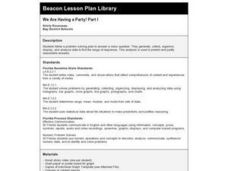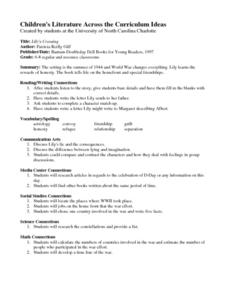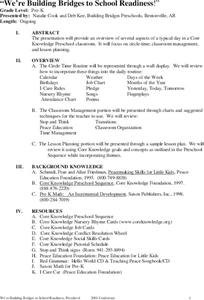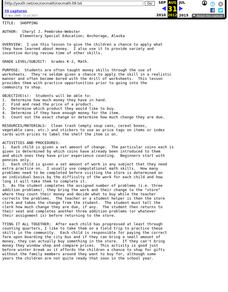Curated OER
Is the Hudson River Too Salty to Drink?
Learners explore reasons for varied salinity in bodies of water. In this geographical inquiry lesson, students use a variety of visual and written information including maps, data tables, and graphs, to form a hypothesis as to why the...
Gwinnett County Public Schools
Analysis of the Tuck Everlasting and The Birchbark House Text Exemplars
Looking to introduce some text-based questions into your ELA lessons? Practice the kinds of skills the Common Core demands with the seven text-based questions and the essay prompt provided here. Designed to be a three-day instructional...
Curated OER
The Hunger Games
Enjoy this exciting novel with your students, and bring the games to life in your classroom!
K12 Reader
Galileo and His Telescope
Learn about Galileo Galilei's contribution to modern science with a reading passage that focuses on reading comprehension. After kids read several paragraphs about his life, they answer five questions about the information they have just...
PBS
Inventions
Use this lesson plan to discuss inventions that have changed your class's world and have impacted society. Middle schoolers investigate important inventions of their time and design an invention in a simulated business atmosphere. Modify...
Curated OER
Designing a Playground!
Students design their own playground equipment. In this design activity, students take pictures of equipment they like and make a class pictograph of their favorite ones. They investigate the design, research equipment around the world,...
Berkshire Museum
Adopt a Schoolyard Tree
Help young scientists connect with nature and learn about trees with a fun life science instructional activity. Heading out into the school yard, children choose a tree to adopt, taking measurements, writing descriptions, and drawing...
Curated OER
Lesson Plan for Cricket's Supper
Interested in a special folktale to read with your class? Then this instructional activity might be for you. Readers will build an understanding of the food chain while creating a storyboard that includes the characters, setting, and...
Curated OER
We Are Having a Party! Part I
Second graders use data analysis skills in order to plan a class party. They graph possible times for the party noting the range for times. They discuss how mathematicians find and use the range to analyze data.
Curated OER
Then and Now
Students explain the differences and time relationships between the past simple, present perfect (continuous) and present simple tenses when speaking about the past and present. They use a graphic organizer before speaking.
Curated OER
Methods of Mystery
Students utilize the scientific method to discover the age of an item. In this historical dating lesson plan, students compare and contrast a 400 year old cabinet to one made within a few years by using carbon dating. Students complete...
Curated OER
Geometry and Quilting
Fourth graders combine geometry and language arts skills while examining quilt-making. After identifying the geometric shapes contained in quilts, they write stories to encompass the quilt border. Students conclude by creating and...
Curated OER
Bingo Brown and the Language of Love
Learners study credit and interest in a novel and consumer math activity. In this credit lesson, students read the book Bingo Brown and the Language of Love. Learners discuss the book and the ideas of credit, interest, and loans....
Curated OER
Bake, Boil, or Fry
Young scholars write a journal entry about where there food comes from. For this Civil War lesson, students discuss journals, the crops grown within the U.S., the import/export process and what food preparation must have been like on a...
Curated OER
Changes in Latitudes, Changes in Attitudes
Sixth graders discuss how people, society, and technology change over time through a unit of integrated lessons. In these changes in society lessons, 6th graders discuss the answers to many questions about how changes effect the...
Curated OER
Lost in Translation
Students reflect on the uses of mathematics in their daily lives and work in pairs to design brochures that make specific mathematical concepts clear and interesting to a popular audience.
Curated OER
Lily's Crossing
Middle schoolers listen to a story, "Lily's Crossing," about life during a World War. After completing worksheets, they compare and contrast characters in the story. Using math skills, students develop a time line of the war, calculate...
K5 Learning
Susie and Rover
Reinforce reading comprehension skills with a two-page learning exercise offering a story about a young girl, her dog, and an important life lesson. Scholars read the text then show what they know through four short-answer questions.
Curated OER
A VIP - Present Perfect Simple and Continuous
Here is an interesting way to teach the present perfect and present perfect continuous. Individuals practice these verb tenses as well as the simple past by asking a partner questions about an imaginary biography. The biography is...
Curated OER
Families and Communities
Here is a week-long lesson on the roles of family members designed for first graders. In it, learners share stories of their families, listen to books about families read to them by their teacher, complete homework assignments and...
Curated OER
What Language Do You Speak?
Fourth graders engage in a lesson based on a game and is to be played in groups. A card be drawn from a deck. On this card is a verbal description of a mathematical statement. They use worksheets imbedded in this lesson which give...
Curated OER
We're Building Bridges to School Readiness!
Students participate in the activities their teaching initiates from the packet for classroom behavior, social skills, and learning environments.
Curated OER
Track Traces
Learners explore animal characteristics by participating in an animal anatomy activity. In this animal tracks lesson, students identify the differences between specific animals and the shape of their footprints. Learners utilize a...
Curated OER
Shopping
Students do a shopping simulation in order to have a chance to apply their math skills in a real life fashion. They decide how much money they have, what they want to buy, if they have enough money and how much change they should get back.

























